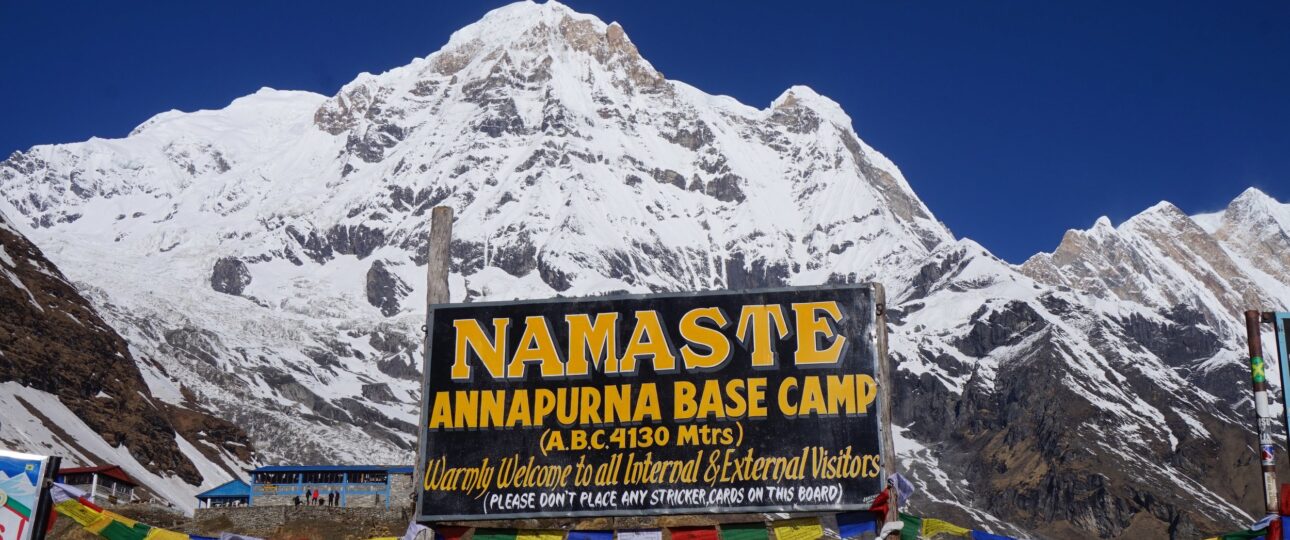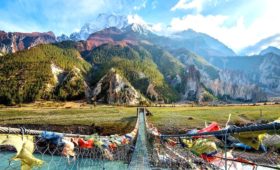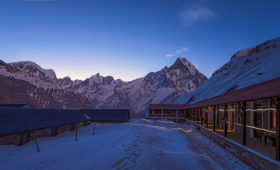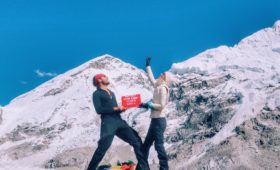The Annapurna Base Camp trek offers a thrilling and famous trail in the lap of the Himalayas, reaching a maximum height of 4,130 meters. It is undoubtedly the top choice for trekkers seeking diverse cultural and natural experiences. Renowned for its breathtaking Himalayan views, including Mount Dhaulagiri, Annapurna I-III, and Machapuchhre, it stands as the world’s most popular trekking destination.
Also known as the Annapurna Sanctuary Trek, ABC Trek is accessible and shorter than other high-altitude treks. Considering the Annapurna Base Camp Elevation, the trek starts from Pokhara and the journey takes you through Ghorepani with panoramic views and stops at Ghandruk, Chomrong, Deurali, Machhapuchhre Base Camp, and finally, Annapurna Base Camp at 4,130m/13,549ft.
As we ascend to Annapurna Base Camp, the elevation rise provides stunning views of Annapurna I, Annapurna III, Hiunchuli, Khangsar Kang, and Machhapuchhre. The trek encompasses diverse landscapes, rich traditional culture, and varying climatic conditions, creating an unforgettable adventure.
Annapurna Base Camp Trek Highlights:
- Breathtaking view of mountains, including Annapurna I, III, South, and others.
- Awe-inspiring views of the traditional Gurung settlements, ever-flowing rivers, and rush green forests.
- Immerse yourself in the breathtaking beauty of the Annapurna Conservation Area and encounter endangered creatures including Snow leopards, graceful Musk deer, majestic Himalayan Tahr, and birds like Spiny Babbler.
- Reach Jhinu Danda’s natural hot springs and take a soothing bath.
How High Is Annapurna Base Camp?
The Annapurna Base Camp Elevation is 4,130 meters (13,550 feet). That makes it more than 1,234 meters lower than Everest Base Camp. Situated at the foot of the Annapurna mountain range, Annapurna Base Camp offers unrivaled views of some of the highest peaks in the world.
The journey starts in Pokhara with a drive to Kimche and then a trek to Ghandruk, at 1940 meters. As you make your way along ancient trails towards Base Camp over the course of 7-10 days, you’ll steadily gain elevation with each step.
Here’s what to expect at certain points:
- Ghandruk – 1,940 meters above sea level. This village comes with the magnificent views of Mt. Annapurna, Machhapuchhre, Dhaulagiri, and Hiunchuli.
- Deurali – 3,230 meters above sea level. Most trekkers stay overnight at Deurali, enjoying the views of the Machhapuchhre and Annapurna.
- Machhapuchhre Base Camp – 3,700 meters above sea level. Located at the foothills of Mt. Machhapuchhre, it offers epic views of the Fish Tail peak.
- Annapurna Base Camp – 4,130 meters above sea level. You can enjoy the stunning views of the Annapurna massif and Machhapuchhre. The scenery of the surroundings are unmatching.
The increase in elevation also brings a decrease in oxygen. Make sure to ascend slowly, stay hydrated, get proper rest, and listen to your body every step of the way.
Details Regarding Annapurna Base Camp Trek Elevation
Kathmandu to Pokhara to Ghandruk
The Annapurna Base Camp Trek Elevation includes the elevation gain starting from Kathmandu and Pokhara. Starting the trek in Kathmandu at 1,350 m (4,429 ft), the journey involves a flight from Tribhuvan International Airport to the picturesque Pokhara at 822 meters (2,597 feet), surrounded by lush greenery.
By the time we reach Pokhara, we will be losing the elevation by around 528 meters. And the elevation gain starts from Pokhara as we drive up to Kimche and embark on a hike to Ghandruk at 1940 meters above sea level. Elevation gain from Pokhara to Ghandruk is around 1118 meters.
Ghandruk to Deurali
The next move is to reach Deurali from the beautiful village of Ghandruk. Traversing the picturesque Ghandruk trails initiates the trek, encompassing a 5-6 hour ascent to Chhomrong village at 2,170 m (7,120 ft), renowned as a crucial overnight halt for trekkers.
From Ghandruk to Deurali, the elevation gain will be around 1290 meters. The trek includes a climb to Bamboo, reaching an altitude of 2,310 m (7,579 ft). The arduous journey continues, reaching 3,230 m (10,598 ft) as you trek for 3-4 hours from Bamboo to Deurali.
Deurali to Machhapuchhre Base Camp to Annapurna Base Camp
This is the last phase of the trek, where trekkers will start their hike from Deurali (3,230 m) to Annapurna Base Camp (4,130 m). Today, the elevation gain will be around 900 meters.
The rocky pathways, particularly through Deurali, pose physical demands, requiring trekkers to conquer varying elevations. The ascent to Machhapuchhre Base Camp, situated at 3,700 meters (12,139 feet), offers a mesmerizing view of the iconic Mt. Machhapuchhre. Elevation gain from Deurali to Machhapuchhre Base Camp is around 470 meters.
The final push to Annapurna Base Camp, towering at 4,130 meters (13,551 feet), demands resilience and stamina. The elevation gain from Machhapuchhre Base Camp to Annapurna Base Camp is 430 meters.
Challenges and Preparations:
The allure of the Annapurna Base Camp (ABC) Trek lies in its breathtaking scenery, diverse landscapes, and the opportunity to witness the majestic Annapurna massif up close. However, embarking on this iconic trek demands more than just a sense of adventure.
The increasing elevation and rocky trails that characterize the journey present formidable challenges, necessitating proper health conditions, physical preparation, and a strategic approach to backpacking.
One of the foremost challenges faced by trekkers on the ABC trail is the relentless ascent in altitude. As one ventures higher into the Annapurna region, the air becomes thinner, and the risk of altitude sickness looms large.
Altitude sickness, also known as acute mountain sickness (AMS), is a condition triggered by the reduced air pressure and lower oxygen levels at higher altitudes. Symptoms can range from mild discomfort, such as headaches and fatigue, to more severe manifestations like nausea, dizziness, and breathlessness.
To mitigate the risk of altitude sickness, trekkers must be mindful of the gradual ascent and acclimatization. Rushing the climb without allowing the body to adjust to the changing conditions increases the likelihood of falling prey to AMS.
Adequate acclimatization breaks, where trekkers spend a day at a higher altitude to acclimate before ascending further, are crucial for minimizing the risk. Additionally, staying well-hydrated and avoiding excessive physical exertion during the initial days of the trek can help the body adapt more effectively.
Proper health conditions are crucial for a successful ABC trek. Individuals with pre-existing medical conditions, particularly those related to the respiratory or cardiovascular systems, should consult with a healthcare professional before undertaking the journey.
Tips for Safety During Annapurna Base Camp Trek
Prepare in Advance:
Begin your preparations well ahead, both physically and mentally. Ideally, start about a month prior to the trek, allowing time for a final review of your essential kits.
Train:
Physical fitness is crucial for the Annapurna Base Camp Trek, involving 6 to 7 hours of walking daily. Regular walking or jogging, coupled with cardio and gym workouts, will enhance your endurance and overall fitness.
Wear Comfortable Clothing:
Opt for lightweight and comfortable clothing to facilitate your hike. Bulky and uncomfortable attire can hinder movement, so choose weather-appropriate outfits based on the forecast.
Stay Hydrated and Healthy:
Given the physical exertion, prioritize staying hydrated and consuming nutritious food. Avoid alcohol and narcotics, focusing on replenishing your body with water and healthy snacks.
Hire a Guide and Porter:
Ensure compliance with trekking regulations in Nepal by hiring an experienced guide. A guide aids navigation and cultural interactions. Consider hiring a porter to carry your luggage if managing a backpack becomes challenging.
Always Carry A First Aid Kit
While embarking on this journey, trekkers must always carry a first aid kit. Since this trek is fully remote, there’s nothing that cannot happen, so in case the injury happens, the first aid kits will help you relief the pain.
First aid kit should contain the basic absorbent compress dressings, adhesive bandages (assorted sizes), adhesive cloth tape, antibiotic ointment packets, sterile gauze pads, Tweezers, and so on.
Conclusion
Annapurna Base Camp might be the better choice if you are looking for a moderate challenging experience with adventures. trek due to its higher elevation and rougher terrain. Those who go for this destination must consider the key factors like elevation, challenges, and plan and decide accordingly. It will be easy for them to pursue the trek and help manage costs.
Annapurna Base Camp Trek Elevation must be considered by every trekker as the high altitude is prone to altitude sickness. We recommend acclimatizing and preparing all the necessities before embarking on this beautiful journey.
Do you have any question about trip to Nepal?
Tell us about your trip to Nepal and what you expect from it. We will answer your questions in 24 hours and help you design a trip with a comfortable itinerary to best meet your needs.





